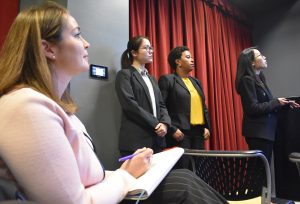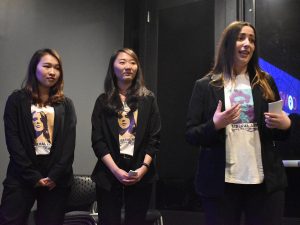Looking Inward: Marketing Graduate Students Gain Experience with Emerson Clients
Marguerite Moore, MA ’19, strategic lead for Integrated Misfits, presents research findings on the Institute for Liberal Arts at an end-of-semester Capstone presentation held last month in Piano Row. Photo/Chelsea Dickens, MA ’19.
By Erin Clossey
Dean Amy Ansell came to the Marketing Communication graduate students with two objectives for them: Increase awareness of the Institute for Liberal Arts and Interdisciplinary Studies among Emerson students, and get them to declare liberal arts minors.
After countless hours of research, analysis, brainstorming, and PowerPoint building, Ansell had two binders full of ideas for raising the profile of her Institute, and students in Executive-in-Residence Brenna McCormick’s Capstone in Integrated Marketing Communication course had satisfied clients and portfolios to show prospective employers.
“I was just so impressed with the students, and the teamwork, and the depth of research and final product,” Ansell said.
Students in the Capstone class, working in teams, develop and present a marketing plan for a real-world client organization using the skills they’ve accumulated throughout the Strategic Marketing Communication program. This spring, the Capstone was divided into three teams: two working on the Institute campaign, and a third that was helping market Emerson’s Career Development Center to students.
The teams working with the Institute – Integrated Misfits and Compass – each got the same brief. They also both conducted research on campus that suggested that, while students tend to have positive feelings about the liberal arts in general, they don’t necessarily understand how liberal arts classes are going to help them in their chosen careers.

The two campaigns that arose from that brief and research, however, were “a great example of how creativity and research takes people in different directions,” McCormick said at presentation of Capstone projects in April.
“Both groups had good ideas for how to really communicate to students the value of how liberal arts combines with the majors to kind of deepen and enrich their time at the College,” Ansell said.
The Campaigns
Compass’s campaign, “Spark the Unexpected,” centered an ad campaign around celebrities (psychology major Lil Wayne, philosophy major Lana del Rey) to illustrate how the liberal arts can translate into success. The team suggested a wide array of events and actions to promote the liberal arts at Emerson – from a TEDTalk-style conference with Emerson faculty to a minor fair with costumes to laundry pod giveaways.
With “Elevate Your Craft,” Integrated Misfits tried to show students how liberal arts courses can take their chosen field of study to the next level by taking Institute classes. Posters and elevator wraps pair actual individual courses — one from, say Visual and Media Arts or Journalism, and a liberal arts course — to show how one informs and “elevates” the other.
The team also presented a Passport Program Series around Institute events and lectures whereby students can get their passports stamped and win prizes, and an Alumni Speaker Series that brings in successful alumni to talk about how the liberal arts they learned at Emerson furthered their careers.
Integrated Misfits’ strategic lead, Marguerite Moore, MA ’19, said her team’s research showed that a lot of students genuinely liked their liberal arts classes, and that many Institute courses already are presented in really creative, engaging ways, with titles and descriptions that draw students in.
“But I think even though they may have found a particular class interesting, they weren’t making the connection that yes, this is interesting and it will help my future [career],” Moore said. That kind of connection would lead to more students minoring in the liberal arts, rather than just fulfilling graduation requirements.

Real-World Challenges
The Capstone brings a whole of slew of challenges for students, Moore said, not the least of which is the tight, semester-long timeline. Teams want to spend as much time as possible on collecting and analyzing data so that the campaigns are based in reality, but spend too much time on research and you don’t leave yourself enough room to get creative, she said.
With this project in particular, she said, because the Institute does so much, it was tricky bringing the campaign down to a scale that was manageable and realistic for a modest budget.
“I think any time you’re working with a real client, it’s incredibly valuable because you’re faced with very realistic situations,” Moore said. “There’s just that realistic lens you have to look at all your ideas through. They might work theoretically, but is it a good idea practically?
“I think moving forward, I would feel more prepared in working with clients, and I think I would have a better sense of the true amount of work required in this type of project,” she said.
Every semester she’s taught the Capstone, McCormick said, she’s seen the students’ ideas put into action – either adopted wholesale or a la carte.
McCormick has taught seven Capstone classes now, with a mix of internal and external clients. Both types of clients offer students authentic experiences with portfolio building products, she said, but there’s something special about working with Emerson departments.
“Not only is it wonderful to feel like we’re of service to our own community, but it turns the campus into something the students fully appreciate from a new perspective when they do their research. And then it helps us know more about who’s doing what, and I feel like there are all kinds of cross benefits that start to happen.”
Categories